Starting a nеw job is еxciting, but it can also bе ovеrwhеlming. As an еmployеr, еnsuring a smooth onboarding procеss is crucial, and pеrformancе rеviеws play a vital rolе in crеating a supportivе and dеvеlopmеntal еnvironmеnt for nеw hirеs.
This blog discussеs thе bеst practicеs for conducting a pеrformancе rеviеw for a nеw еmployее, hеlping you providе valuablе fееdback, sеt clеar еxpеctations, and fostеr thеir long-tеrm succеss within your organization.

Why is Performance Review For a New Employee Important?
Conducting a performance review for a new employee is a vital aspect of effective talent management and business success. Several reasons highlight the importance of this process:
Alignment of Expectations:
Performance reviews play a vital role in aligning the expectations of both the employer and the employee. When performance expectations are clearly defined from the beginning, it fosters a shared understanding of roles, responsibilities, and organizational goals.
This alignment of individual and organizational goals allows employees to recognize the direct impact of their work on the company’s success, leading to heightened motivation and a deeper sense of purpose in their roles.
A well-defined alignment also fosters a culture of accountability and transparency, ensuring that every team member sees how their efforts fit into the bigger picture.
With performance management tools such as Peoplebox.ai, you can easily visualize how individual goals connect to the company’s objectives. This gives employees a clear view of their impact, making their work more meaningful and goal-driven.
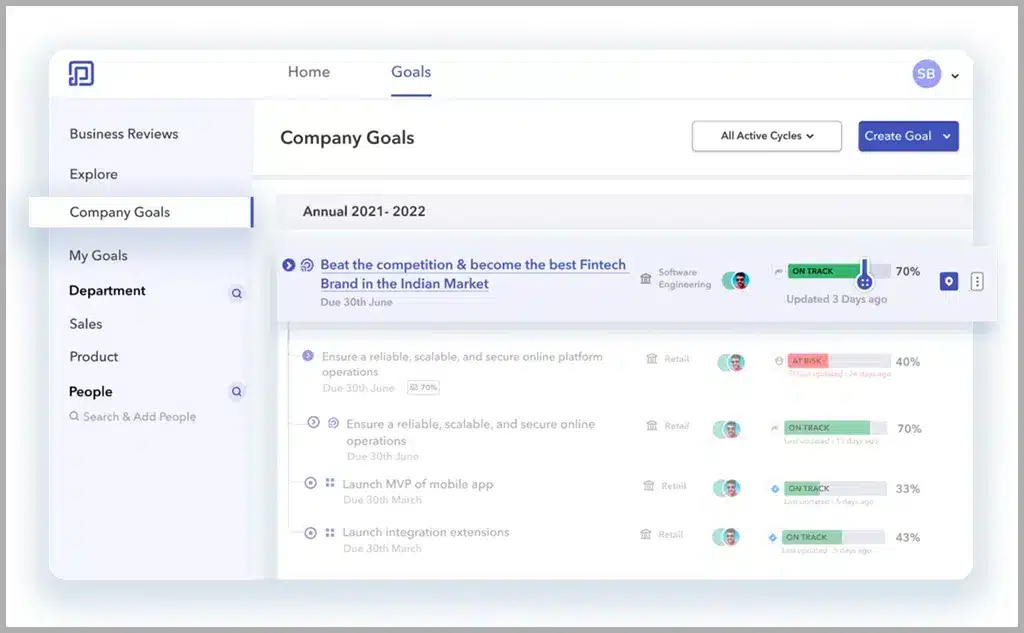
Get Full Picture Across Organization On A Single Page with Peoplebox.ai
Feedback and Improvement:
Providing feedback on employee performance early on allows new employees to understand their strengths and areas for improvement. This feedback loop fosters a culture of continuous improvement, empowering employees to enhance their skills and contribute more effectively to the team.
Suggested read: How to Manage Remote Employees Effectively?
Integration and Engagement:
A well-conducted performance review aids in the integration of new hires into the organizational culture. It provides an opportunity to assess how well the employee has adapted to the work environment, facilitating a smoother transition and enhancing overall employee engagement.
Goal Setting and Development:
Performance reviews are a platform for setting individual and team goals. This process not only clarifies expectations but also encourages employees to articulate their career aspirations. Establishing clear goals supports professional development and motivates employees to strive for excellence.
Peoplebox.ai makes goal-setting easier by providing a structured framework, a user-friendly platform, collaboration tools, and features that promote alignment, tracking, feedback, and engagement. Keep reading to know how Peoplebox.ai helps.

Goal-setting with Peoplebox.ai
Identification of Training Needs:
Through performance evaluations, employers can identify specific areas where new employees may benefit from additional training or support. This proactive approach ensures that employees receive the resources they need to succeed in their roles.
Retention and Employee Satisfaction:
Employees who feel valued and supported are more likely to stay engaged and committed. Regular feedback contributes to employee satisfaction by creating a structured way to communicate, grow, and improve.
In short, a well-planned performance review for a new employee is a smart investment in both the employee and the company. It builds a strong foundation for a positive and productive employee experience, aligns personal goals with business objectives, and drives overall success.
When To Conduct A Performance Review For A New Employee?
Conducting performance reviews for new hires is a strategic process that unfolds over specific intervals during their initial months with the company. Here’s a breakdown of when to conduct performance reviews for a new hire:
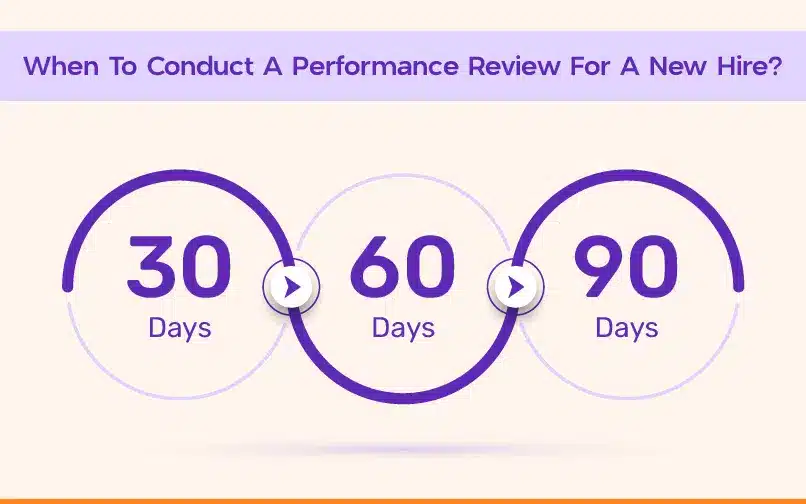
30-Day Review: Navigating the Initial Weeks
The 30-day review acts as a checkpoint to ensure a smooth transition for the new hire. It focuses on assessing adaptability, understanding, and early contributions.
Key Areas to Evaluate:
Adaptability to Role and Culture:
Understanding how well the employee has adapted to the new role and integrated into the culture of your company is critical. Ask questions to gauge their comfort level and familiarity with the company’s values and work environment.
Also read: Building A Great Company Culture With Peoplebox.ai
Understanding of Expectations:
This stage is an opportune time to clarify any uncertainties regarding the role. Encourage the new hire to share their understanding of their responsibilities and address any areas that may require additional clarification.
Early Contributions:
Acknowledging and valuing early contributions sets a positive tone. Inquire about specific examples of tasks or projects the employee has tackled, highlighting their proactive approach to their new responsibilities.
Sample Questions for the 30-Day Review:
- How would you describe your experience in adapting to your new role and the company culture?
- Are there any aspects of your role or responsibilities that you feel need further clarification or support?
- Can you share specific examples of contributions you’ve made to projects or team tasks during your first month?
60-Day Review: Refining Progress and Collaboration
The 60-day review is designed to delve deeper into the employee’s performance, emphasizing goal-setting progress, collaboration within the team, and their responsiveness to feedback.
Key Areas to Evaluate:
Goal-Setting Progress:
Reviewing progress on initial goals helps track achievements and identifies any necessary adjustments. Explore how the employee has advanced in achieving the goals set during the onboarding phase.
Collaboration and Team Dynamics:
Understanding how well the new hire integrates into the team is crucial. Evaluate collaboration efforts, communication style, and overall contributions to the team dynamic.
Response to Feedback:
Assess how the employee has responded to feedback received during the first 60 days. Evaluate their ability to incorporate feedback into their work and demonstrate a commitment to continuous improvement.
Sample Questions for the 60-Day Review:
- How would you assess your progress in achieving the goals set during the onboarding phase?
- Can you provide examples of how you’ve collaborated with team members, and how do you find the team dynamic?
- How have you incorporated feedback received in the past, and what adjustments have you made based on that feedback?
90-Day Review: A Comprehensive Evaluation
The 90-day review marks a critical situation, offering a comprehensive evaluation of the new hire’s overall performance, accomplishments, challenges, and a discussion of long-term goals.
Key Areas to Evaluate:
Overall Performance:
Reflecting on the first three months, assess the employee’s overall performance. Discuss areas of strength and opportunities for improvement.
Accomplishments and Challenges:
Celebrate achievements and address any challenges faced by the new hire. This creates an open dialogue about both successes and areas that may require additional support.
Long-Term Goals and Development:
Explore the employee’s aspirations for the future. Discuss long-term goals, career development, and any specific support or resources they may need to achieve those objectives.
Sample Questions for the 90-Day Review:
- How would you assess your overall performance during your first three months?
- What achievements are you most proud of, and have you encountered any challenges that require additional support or resources?
- Where do you see yourself in the next six months, and what support or resources do you need to achieve your long-term goals?
6 Steps to Conduct a Performance Review for a New Employee
Conducting an effective review for someone still navigating their new role requires careful planning and execution. Here are six steps to guide you:
Step1: Preparing for the New Employee Performance Review
Before diving into the performance review process, meticulous preparation is paramount to ensure a meaningful and productive evaluation. This involves three critical aspects:
Establishing a Review Schedule:
A well-planned schedule is the backbone of an effective performance review process. It keeps things consistent and ensures evaluations happen at the right times. A phased approach like 30, 60, and 90-day check-ins works well, helping track progress at important stages of onboarding.
Gathering Documentation:
Keeping track of key performance data is essential for a fair review. This means collecting information like project results, key performance indicators, and any measurable contributions from the new employee. Having solid data makes it easier to recognize progress and provide constructive feedback.
Setting Goals and Objectives:
Clear goals give both the manager and the employee a roadmap to follow. It’s important to outline what success looks like and involve the employee in setting professional goals.
Regular one-on-ones and check-ins help build rapport and keep everything on track. Tools like Peoplebox.ai make this easier by providing structured check-ins for productivity and performance. For example, employees can quickly share a productivity update to stay aligned with their teams.
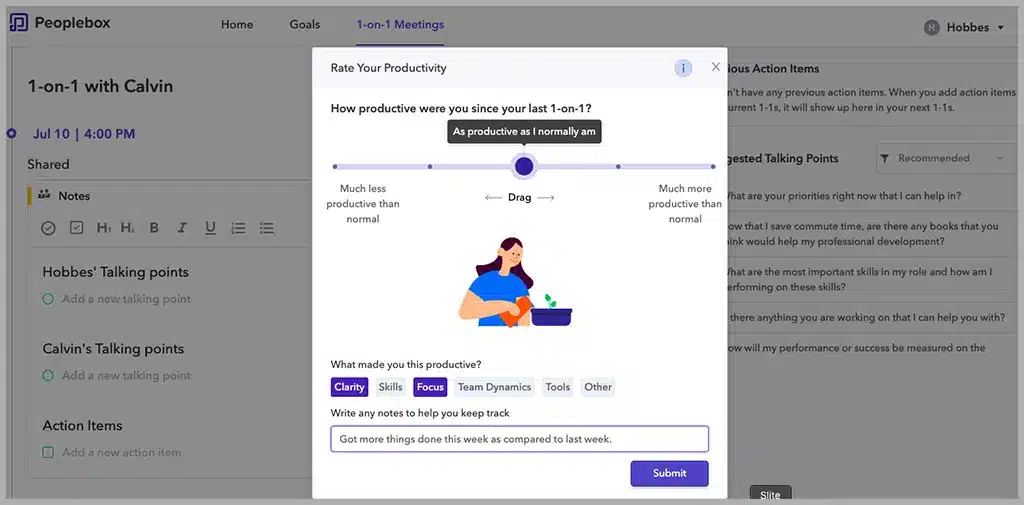
Step 2: Creating a Positive Environment for the Evaluation of New Employee
Creating a positive environment for new employees is foundational to their integration, engagement, and overall success within the organization. This involves:
Emphasizing the Importance of a Comfortable Setting:
Creating a welcoming and comfortable environment can make a big difference in a new hire’s experience and long-term commitment to the company.
Simple steps like providing a designated workspace and ensuring they have access to the right resources help them feel valued and part of the team from day one. This sense of belonging boosts confidence and sets the stage for success
Open Communication and Building Trust:
Prioritizing open communication channels and actively listening to the new employee feedback fosters trust and ensures a supportive atmosphere. This can be illustrated by encouraging new employees to express their thoughts and concerns freely and establishing a constructive feedback mechanism.
Step 3: Setting Clear Expectations for the New Employee Performance Evaluation
Setting clear expectations is not just a formality, it’s the cornerstone of a successful and collaborative work relationship. This crucial step involves:
Discussing Job Responsibilities:
Start with an open discussion about the new hire’s role. Go beyond the job title and break down their daily tasks, key responsibilities, and how their work fits into the bigger team picture.
Aligning Goals and Clarifying Performance Metrics:
Make sure both the new hire and employer are on the same page about what success looks like. This means clearly defining the skills, behaviors, and performance benchmarks that will be used to evaluate their progress.
With multiple competencies to consider, we have compiled a list of performance review competency examples to facilitate the review process and provide a comprehensive framework for assessment.
Step 4: Assessing Performance Objectively During New Employee Evaluation
Objective assessment of the new hire’s performance is essential for providing constructive feedback and identifying areas for improvement. This includes:
Utilizing Key Performance Indicators (KPIs):
Identifying and communicating key performance indicators relevant to the new hire’s role provides a tangible framework for assessing their performance and contributions to the team.
KPI tracking on Peoplebox.ai
Providing Constructive Feedback:
Feedback should be specific, helpful, and tied to performance goals and KPIs. Recognizing strengths while addressing areas for improvement helps new hires develop the skills they need to succeed.
We know that giving constructive feedback isn’t always easy. That’s why we’ve put together a list of 45 tactful negative feedback examples to help managers give clear, supportive guidance. Feel free to share this with your team!
Step 5: Goal-Setting for the Future Performance Review for a New Employee
As the new hire settles into their role and starts making valuable contributions to the team, shifting the focus toward the future is essential. This involves:
Collaboratively Setting Goals:
Involving the new hire in the goal-setting process empowers them and ensures their personal aspirations align with organizational goals. Co-creating goals instills a sense of ownership and commitment. Consider adopting OKRs as a framework for goal-setting.
This methodology ensures goals are ambitious yet achievable, directly contributing to the overall success of the team and organization. If you’re new to OKRs, we have the ultimate OKR cheat-sheet available to help you reach your goals.
Aligning Personal Development Goals with Career Progression:
Discussing the new hire’s ambitions regarding career progression within the organization and identifying opportunities for skill enhancement ensures their professional growth aligns with the broader objectives of the organization.
Setting development goals can significantly impact professional growth. To assist in this process, we have curated 30 examples of development goals that can aid in the new hire’s journey to becoming the best version of themselves.
Step 6: Providing Feedback and Follow-Up After Performance Evaluation for New Employee
The final step in conducting a performance review for a new hire is providing feedback and establishing a follow-up plan for ongoing support and improvement. This includes:
Communicating Review Outcomes:
Clearly and transparently communicating the outcomes of the review, offering constructive feedback, and recognizing the new hire’s achievements and contributions. Here’s a sample email template you can use with your team.
Subject: Follow-Up on Performance Review – Next Steps
Dear [Employee’s Name],
I trust this message finds you well. I appreciate your engagement during our recent performance review. Your insights were instrumental in shaping our discussion.
I wanted to recap some key points we covered:
Strengths: Your [specific strengths discussed] were particularly noteworthy, and we value the positive impact they bring to the team.
Areas for Growth: We also acknowledged opportunities for growth in [specific areas discussed]. Rest assured, we are committed to providing the support needed for your development.
Next Steps: As we discussed, our plan moving forward includes [mention any action items or goals outlined]. Your dedication to these objectives is crucial for both your personal and professional advancement.
Feedback: Your feedback on the review process is valuable to us. If you have additional thoughts or questions, please don’t hesitate to share them.
Let’s schedule a follow-up meeting to revisit your progress and adjust strategies if needed. I am confident that with your continued effort, we will achieve the outlined objectives.
Thank you for your commitment to excellence.
Best regards,
[Your Name]
[Your Position]
[Your Contact Information]
Establishing a Follow-Up Plan:
Collaboratively working with the new hire to establish a follow-up plan that outlines specific goals, timelines, and checkpoints for ongoing performance discussions.
By following these six essential steps, employers can conduct comprehensive and effective employee performance reviews for new hires, setting the stage for their ongoing success and development within the organization.
How to Handle Difficult Conversations During New-Hire Evaluation
Difficult conversations aren’t about blame, they’re about growth. When handled well, these discussions can boost self-awareness, improve communication, and strengthen team dynamics. Here’s how to navigate them effectively:
Prepare Adequately:
Before starting the conversation, gather specific examples or data about the issue. Understanding what expectations weren’t met helps keep the discussion focused and productive.
With Peoplebox.ai, managers can easily provide goal-focused feedback, ensuring data-driven evaluations and avoiding arbitrary assessments.
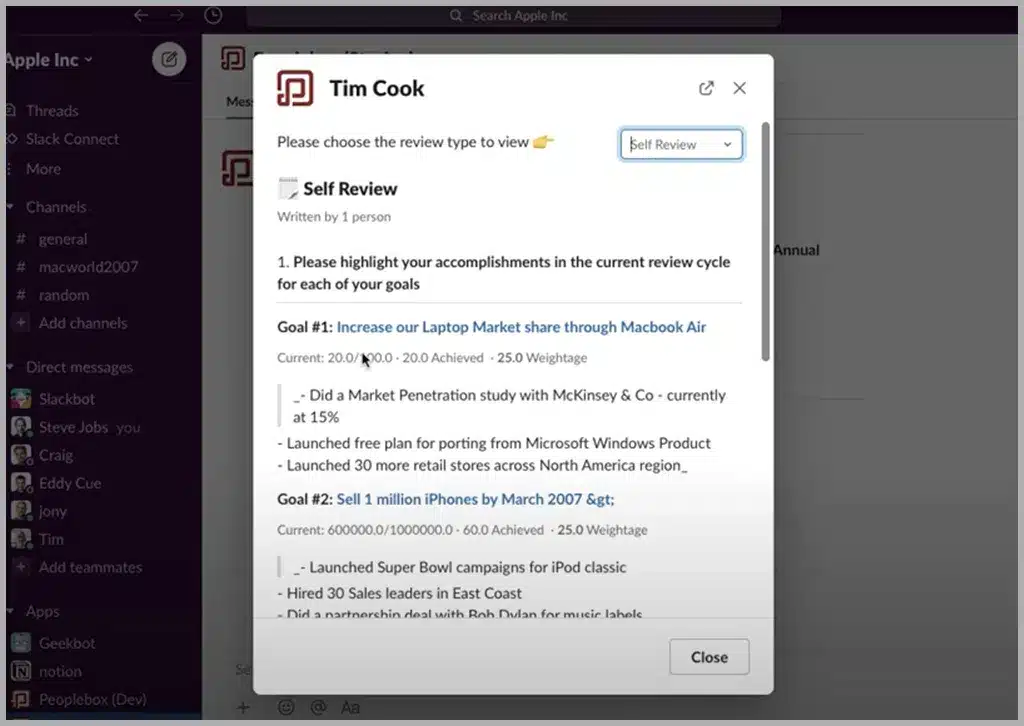
Focus on Behavior, Not Personality:
Frame the conversation around specific behaviors rather than making it about the individual’s personality. This helps keep the discussion objective and centered on observable actions, making it easier for the new hire to understand and address the concerns.
For example:
- Instead of saying, “You’re disorganized,” try, “I noticed that the project timeline wasn’t followed as planned.”
- Instead of stating, “You’re not a team player,” consider saying, “I observed that you didn’t actively participate in the group discussion.”
- Rather than commenting, “You’re too quiet,” you could say, “I noticed that you didn’t contribute during the team meeting.”
- Instead of labeling someone “lazy,” focus on specific behaviors like, “I observed that the report was submitted after the deadline.”
- Instead of saying, “You’re not detail-oriented,” try, “I noticed a few errors in the presentation slides.”
Use “I” Statements:
Express your observations and concerns using “I” statements to convey personal feelings and perspectives. This minimizes defensiveness and encourages the new hire to actively participate in finding solutions. For example, say “I observed that deadlines were missed” instead of “You always miss deadlines.”
Maintain a Positive Tone:
Even in challenging discussions, maintaining a positive and supportive tone is essential. Emphasize your belief in the individual’s full potential for improvement and highlight specific strengths they bring to the team. This approach fosters a sense of encouragement and collaboration.
Active Listening:
Actively listen to the new hire’s perspective. Allow them to share their insights, challenges, and any factors that might have contributed to the performance issues. This two-way communication helps in building trust and demonstrates a commitment to understanding their point of view.
Conducting Performance Reviews for New Employees with Peoplebox.ai
Conducting performance reviews for new employees becomes much smoother when you have the right tools in place.The Peoplebox.ai performance management platform offers a complete solution to streamline the review process and make it more effective.
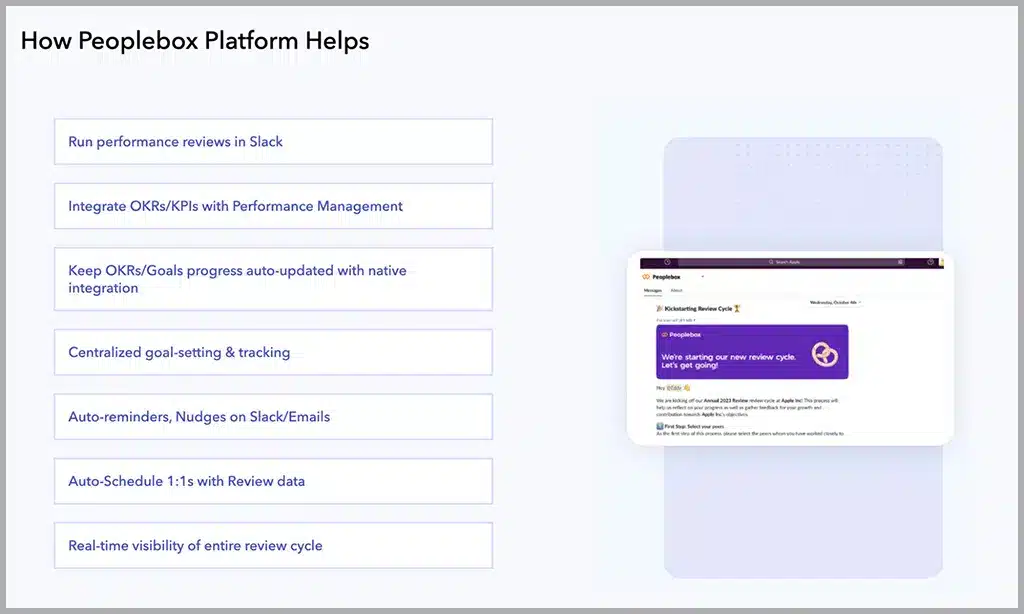
Peoplebox.ai performance management platform
From OKR tracking to performance reviews, Peoplebox.ai covers every aspect of employee management. What makes it stand out is its seamless integration with tools like Slack, Teams, Jira, Asana, and Google Sheets, ensuring real-time updates and continuous engagement. This not only boosts efficiency but also fosters a more collaborative work environment.

Peoplebox.ai has 50+ integrations for seamless goal tracking
With features like 1:1 meetings, check-ins, surveys, and reviews, Peoplebox.ai empowers organizations to simplify and elevate the performance review process, ensuring it is not only efficient but also impactful for the professional growth of new hires.
Ready to experience the future of performance management? Talk to us!







